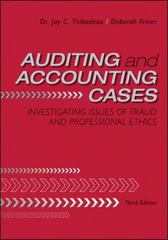The major fixed assets of Waste Managements North American business consisted of garbage trucks, containers, and equipment,
Question:
The major fixed assets of Waste Management’s North American business consisted of garbage trucks, containers, and equipment, which amounted to approximately $6 billion in assets. The second largest asset of the company (after vehicles, containers, and equipment) was land, in the form of the more than 100 fully operational landfills that the company both owned and operated. Under Generally Accepted Accounting Principles (GAAP), depreciation expense is determined by allocating the historical cost of tangible capital assets (less the salvage value) over the estimated useful life of the assets.
From 1988 through 1996, management allegedly made numerous unsupported changes to the estimated useful lives and/or salvage values of one or more categories of vehicles, containers, and equipment.3 Such changes reduced the amount of depreciation expense recorded in a particular period. In addition, such changes were recorded as top-side adjustments at the corporate level (detached from the operating unit level). Most often the entries were made during the fourth quarter, and then improperly applied cumulatively from the beginning of the year. Management did not appear to disclose the changes or their impact on profitability to the investors.
In a letter to the management team dated May 29, 1992, Arthur Andersen’s team wrote, “[i]n each of the past five years the Company added a new consolidating entry in the fourth quarter to increase salvage value and/or useful life of its trucks, machinery, equipment, or containers.” Andersen recommended that the company conduct a “comprehensive, one-time study to evaluate the proper level of WMNA’s salvage value and useful lives,” and then send these adjustments to the respective WMNA groups. However, top management allegedly continued to change depreciation estimates at headquarters.
Because of the nature of landfills, GAAP also requires that a company compare a landfill’s cost to its anticipated salvage value, with the difference depreciated over the estimated useful life of the landfill.4 Waste Management disclosed in the footnotes to the financial statements in its annual reports that “[d]isposal sites are carried at cost and to the extent this exceeds end use realizable value, such excess is amortized over the estimated life of the disposal site.” However, in reality, the Securities and Exchange Commission (SEC) found evidence that Waste Management allegedly carried almost all of its landfills on the balance sheet at cost.
In response to this treatment of landfills on the balance sheet, after its 1988 audit, Andersen issued a management letter to the board of directors recommending that the company conduct a “site by site analysis of its landfills to compare recorded land values with its anticipated net realizable value based on end use.” Andersen further instructed that any excess needed to be amortized over the “active site life” of the landfill. Andersen made similar demands after its audit in 1994. Management never conducted such a study; they also failed to reduce the carrying values of overvalued land, despite their commitment to do so after Andersen’s audit in 1994.
Case Questions
1. Consider the principles, assumptions, and constraints of Generally Accepted Accounting Principles (GAAP). Define the matching principle and explain why it is important to users of financial statements.
2. Based on the case information provided, describe specifically how Waste Management violated the matching principle.
3. Consult Paragraphs .06–.07 of AU Section 319. Do you believe that Waste Management had established an effective system of internal control over financial reporting related to the depreciation expense recorded in its financial statements? Why or why not?
4. Under what circumstances is a company allowed to change the useful life and salvage value of its fixed assets under GAAP? As an auditor, what type of evidence would you want to examine to determine whether Waste Management’s decision to change the useful life and salvage value of its assets was appropriate under GAAP?
5. Consider the role of the Waste Management employee who was responsible for calculating depreciation expense and recording the proper amount in the financial statements. Assuming that the employee knew that the consolidating entries in the fourth quarter recorded by upper management were fraudulent, do you believe that the employee had a responsibility to report the behavior to the audit committee? Why or why not?
Step by Step Answer:

Auditing And Accounting Cases Investigating Issues Of Fraud And Professional Ethics
ISBN: 9780078110818
3rd Edition
Authors: Jay Thibodeau, Deborah Freier





